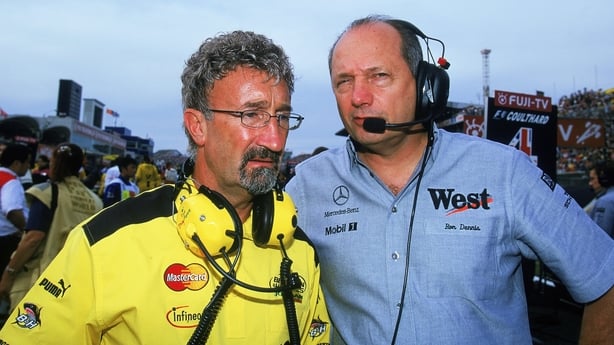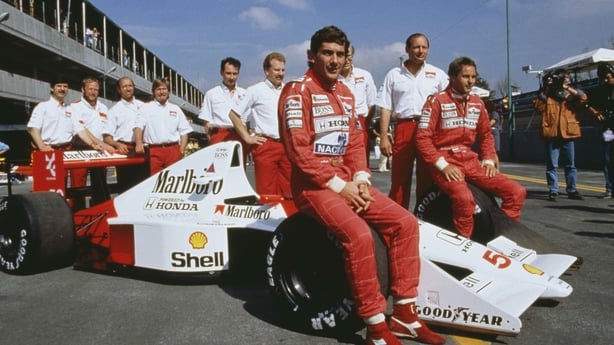"It wasn’t just about the business in the cockpit. He was arranging his sponsorship, his business dealings outside the car and he was in control of every element of his life and racing career. He was the ultimate professional."
The words of PJ Fallon, who raced against the late, great Ayrton Senna da Silva, the iconic three-time Formula One world champion (in 1988, 1990 and 1991) who is still revered to this day, 25 years after his tragic death at the San Marino Grand Prix in Imola on 1 May 1994.
Three days of national mourning followed for the mercurial Brazilian in his home country and around three million people witnessed his coffin being driven through the streets of his home town, Sao Paulo.
While a lot of focus centred on his F1 career and his battles with the likes of his McLaren teammate Alain Prost and Britain’s Nigel Mansell, Senna had - like all racing drivers of his generation - to step-ladder his way through junior formula racing on his way to the top.
It began competitively for Senna in the world of karting, before he made the move to Formula Ford single-seater racing in 1981 and progressed to Formula Three, where he raced for and won the British F3 series having also competed for Eddie Jordan Racing
By 1984 he had made the jump to F1 with the Tolemen and JPS Lotus outfits before the first of his World Championships came in 1988 after a titanic and ill-tempered season-long battle with Prost.
Senna, or Ayrton Da Silva as he was known in his early racing days, also competed in Ireland; he competed in - and won - the 1982 Leinster Trophy races at Mondello Park, which hosted the European Formula Ford 2000 series.
Some of the world’s top drivers have their names etched upon that famous trophy. Alongside Senna are the likes of John Watson, Eddie Jordan and Mika Hakkinen who, like the Brazilian, went onto become an F1 champion.

Hakkinen won the Leinster Trophy in 1988. Senna won the previous season's British Formula Ford 1600 championship, joining the list of winners alongside three Irish drivers - David Kennedy (1976), Kenny Acheson (1978) and Tommy Byrne (1980) - who all won the leading junior Formula event before the Brazilian.
Senna blitzed the 1982 European F2000 series, winning 20 races, and before his visit to Mondello Park, he'd already wrapped up the title.
Thus, on a September evening with fading light, the then 21-year-old Ayrton Senna da Silva (he would later drop the family name and use Senna) lined up on pole position at the County Kildare track for the penultimate round of the series.
Alongside him on the front row was Belfast’s Joe Greenan, mixing it with the European regulars, while PJ Fallon was further back on the grid.
At the green light Senna led into the first corner.
However Greenan refused to yield and as the cars emerged from turn two, the Irishman, in his Van Diemen, had the temerity to take the lead with Senna relegated to second place.
Greenan, who had won the two Irish F2000 championship rounds held that weekend, led the Brazilian for two laps in the 20-lap race, before Senna tried an audacious move down the inside of the Belfast driver into turn three, retaking the lead, which he never relinquished to the chequered flag.
Greenan finished second and exchanged congratulations with Senna on the warmdown lap, the winner having whipped off his helmet to wave to those lucky enough to have been to Mondello to witness a future world champion in action.

Greenan claimed that he missed a gear that day allowing Senna to take the lead, and he has been dining out on the story ever since.
"We all wanted to see what this guy was like," said Fallon, who finished sixth.
"But he was a very secretive, private man who spent most of his time with his mechanics and with his team.
"I remember the drivers' briefing on the morning of the race and Senna was away to the side with one of his mechanics and he didn’t communicate with the other drivers.
"Even at that stage he was creating a mystique around himself and at Mondello that year it was strictly business."
After Mondello, Senna rose through the ranks quickly and was in F1 just two years later, winning three championships before his death, which occurred when his Williams car slammed into the wall at the Tamborello Curve.
Twenty-five years on, the memories of his brilliance burn as brightly as ever.


